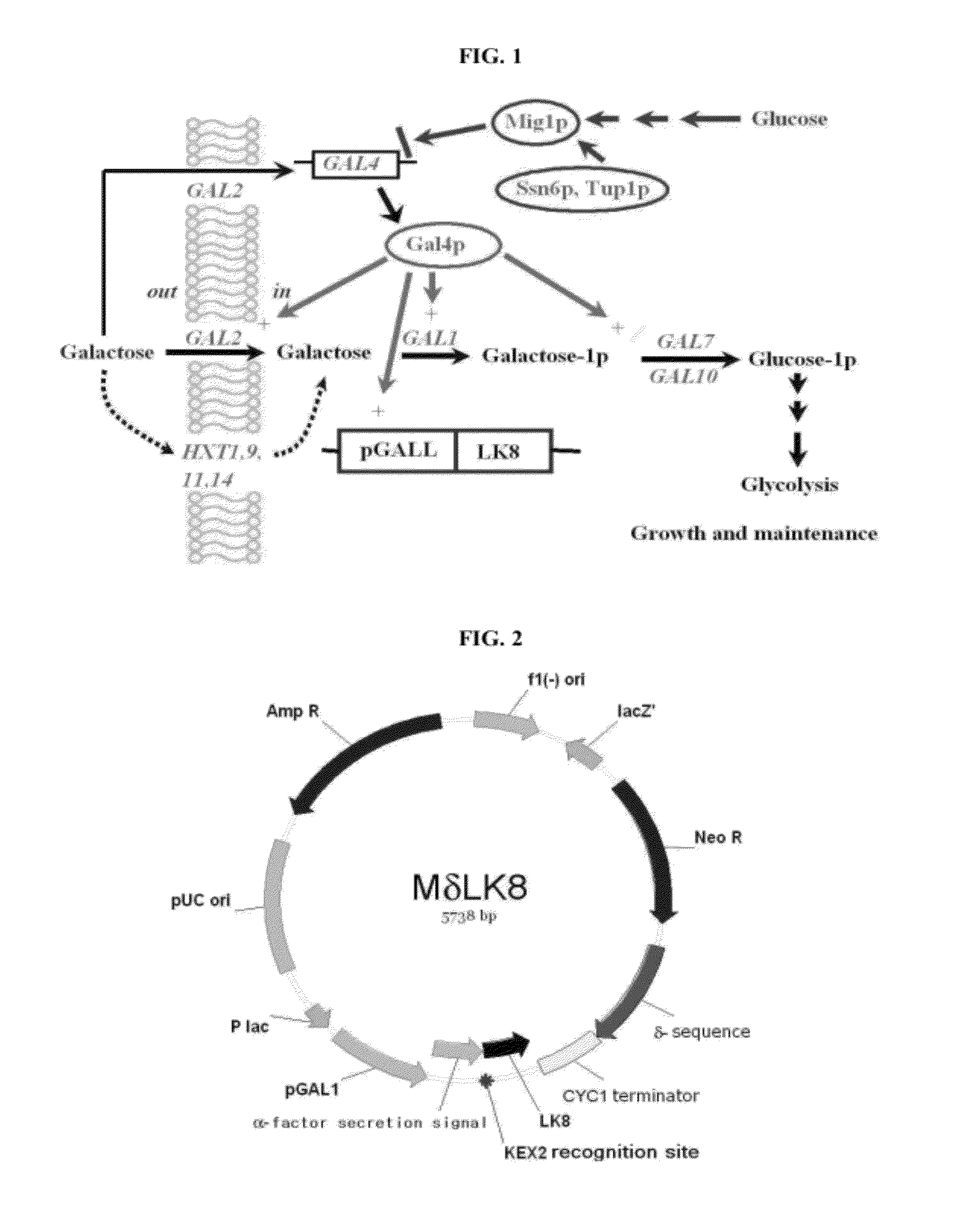Methods for enhancing a secretion efficiency of recombinant foreign protein in yeast expression system
a technology expression systems, which is applied in the field of improving the secretion efficiency of recombinant foreign proteins in yeast expression systems, can solve the problems of reducing the secretion efficiency or cellular dysfunction, reducing the secretion efficiency of foreign proteins, and reducing the incubation temperature. , to achieve the effect of improving the secretion efficiency of a foreign protein, improving the secretion efficiency of a recombinant foreign protein
- Summary
- Abstract
- Description
- Claims
- Application Information
AI Technical Summary
Benefits of technology
Problems solved by technology
Method used
Image
Examples
example 1
Comparison of Intracellular Galactose Transport Capacity Between Yeast Hosts A and B
[0057]Yeast host A (S. cerevisiae 2805, Genotype: MATα pep4::HIS3 prbl-Δ1.6R his 3-Δ200 ura3-52 GAL2 can1, Sohn, J. H. et al. Proc. Biochem., 30: 653-660, 1995; and Kim, T. H. et al. Biotechnol. Lett. 24: 279-286, 2002) and yeast host B (S. cerevisiae BJ3501, Genotype: MATα pep4::HIS3 prb1-Δ1.6R his3-Δ200 ura3-52 gal2 canl, ATCC 208280, USA) were streaked on YPD agar plates and placed in an incubator at 30° C. for about 18 hours, and colonies were isolated. Each colony of yeast strains A and B was inoculated into separate YPG [yeast extract 1% (w / v), peptone 2% (w / v), and galactose 2% (w / v)] liquid media and shake-cultured in an incubator at 30° C. for about 80 hours. In order to determine galactose consumption over time, a residual galactose concentration in the medium was determined by quantification of reducing sugar via 3,5-dinitrosalicylic acid (DNS) assay (Mohun, A. F. and Cook, I. J., J. Clin....
example 2
Construction of Yeast Transformants Secreting Foreign Proteins, Using Yeast Hosts A and B
[0059]2-1. Construction of Yeast Transformant S. cerevisiae 2805 / MδLK8 Secreting Foreign Proteins, Using Yeast Host A
[0060]Co-isolation of an α-factor secretion signal and a LK8 cDNA was carried out using an expression vector pMBR1-LK8 (Korean Patent Publication Laid-open No. 2004-0069840) which was used to produce recombinant LK8 in Pichia pastoris by the present inventors. This application is incorporated by reference herein in its entirety. The pMBR1-LK8 vector was treated with EcoR I for 7 hours, and was washed using a PCR Purification Kit (Qiagen, USA). Then, the vector was treated with BamH I for 7 hours, and DNA was isolated by gel electrophoresis. Using a gel extraction kit (Qiagen, USA), a DNA fragment was obtained which has an α-factor secretion signal of SEQ ID NO: 4 and an LK8 cDNA sequence of SEQ ID NO: 16. The thus-obtained DNA fragment was inserted between a GAL1 promoter and a CY...
example 3
Comparison of Foreign Protein-Secretion Capacity Between Transformed Yeast Strains A and B in Fed-Batch Culture Using Galactose as Carbon Source
[0065]Where yeast transformants A and B constructed in Example 2 were fed-batch cultured using galactose, the following analysis was performed to compare the secretion efficiency of foreign proteins. First, the transformed yeast strains as master seeds were seed-cultured in a YPD [yeast extract 1% (w / v), and peptone 2% (w / v)] medium supplemented with 2% (w / v) glucose at 1 to 3 vvm air and 200 to 1000 rpm for 24 hours, such that desired cell mass and activity (20-fold diluted, OD600=0.8 to 1.2) can be obtained. After seed culture was carried out in the YPD medium, the seed culture solution was inoculated into a starting medium. First, a batch-culture stage is a cell growth period and an adaptation period to galactose that is used as an expression inducer of foreign protein LK8. For this purpose, cells were given a galactose-adaptation period ...
PUM
| Property | Measurement | Unit |
|---|---|---|
| PDI | aaaaa | aaaaa |
| concentration | aaaaa | aaaaa |
| concentration | aaaaa | aaaaa |
Abstract
Description
Claims
Application Information
 Login to View More
Login to View More - R&D
- Intellectual Property
- Life Sciences
- Materials
- Tech Scout
- Unparalleled Data Quality
- Higher Quality Content
- 60% Fewer Hallucinations
Browse by: Latest US Patents, China's latest patents, Technical Efficacy Thesaurus, Application Domain, Technology Topic, Popular Technical Reports.
© 2025 PatSnap. All rights reserved.Legal|Privacy policy|Modern Slavery Act Transparency Statement|Sitemap|About US| Contact US: help@patsnap.com



